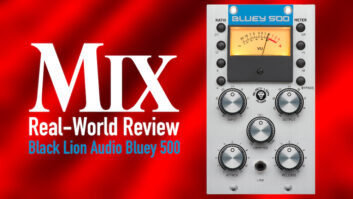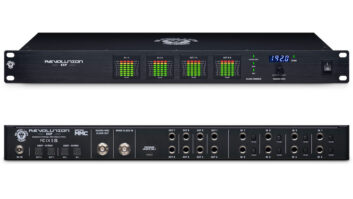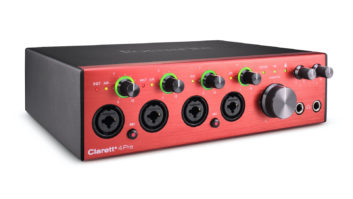
The FM192 is a rebuild of an existing HD 192, offering a new clock and other key components.
The FM192 is a collaboration of Black Lion Audio (BLA) and Requisite Audio Engineering (RAE). Chicago-based Black Lion modifies audio equipment and is best known for its Digidesign 002 and 003 mods, but the company also builds preamps, summing mixers and an external clock. Ventura, Calif.–based RAE builds tube mic preamps and limiters, high-end cables, studio monitors and hi-fi speakers, as well as guitar amps under the Standel brand.
I checked out the FM192 (“Fully Modified”) 192 I/O. This unit has all the functionality of the Digidesign 192, neither losing nor gaining any features of the original, although it sounds better—much better.
Less Is More
The stock Pro Tools HD 192 is heavily filtered to keep unwanted noise out of the audio paths. The circuits work well, giving the Digidesign 192 a very low noise floor, but all that filtering takes a toll on the audio. The upgrade’s design criteria was to remove as much of the filtering as possible while increasing the performance of the converters and the analog sections. The BLA/RAE FM192 modification starts by reducing ripple and capacitive reactance in the power supply. The internal master clock has been replaced with a patented low-jitter, low-noise clock that is said to rival the performance of a rubidium clock. Having lowered clock and power supply noise, the redesign turned to the analog circuits, removing buffers and filtering. While the A/D and D/A converter chips remain intact, the circuits around the chips have been reconfigured.
Listening Tests
For my first test, I brought an 8-channel FM192 into Glenwood Place Studios (Burbank, Calif.) where I was doing drum overdubs. There is no functional difference between a Digidesign 192 and the FM192, so it easily integrates into a Pro Tools HD system. I bused eight of the tracks simultaneously into the Digidesign 192 and the FM192 so I could record the same drums with two different interfaces.
While doing these tests, I realized a flaw in my test setup. I had to choose which device would be the master clock. If part of the FM192’s sonic improvement comes from its clock, then clocking the Digidesign 192 to the FM’s clock would theoretically improve the sound of the former. If I used the stock 192’s clock, the FM would take an unfair sonic hit by being forced to clock to the standard Digidesign clock. With that in mind, we listened to the tracks, clocking the playbacks alternately with the two clocks. Everyone in the session agreed that the FM clock sounded better, so we stayed with it for the rest of the overdubs. I could quickly A/B the A/D conversion simply by selecting a different input. In every case, the FM192 sounded better than the Digidesign 192, even though the FM clock improved the sound of the stock 192.
In my home studio, after more listening, the FM tracks sounded a little scooped out in frequency. It reminded me of the common mastering practice of cutting a little 200 Hz in order to clear up a mix. In contrast, the Digidesign 192 sounded puffy, murky or like the unit’s frequency response had a bump around 180 Hz. I ran some tones and found both devices to be extremely flat, within ±0.25 dB from 20 to 19k Hz. Whatever difference I heard was substantial but not due to frequency response.
For my second test, I recorded a Martin D35 acoustic guitar with two spaced omni mics, placed a few feet away from the guitar to pick up some stereo ambience with some natural decay. In this test, the FM exhibited an extension along each axis—X, Y and Z. The soundstage (X) seemed wider, but not in a “phase-y” way. At the same time, the center of the image—the picture of the guitar emanating from the speakers—seemed more solid or focused in the middle, between the speakers. I know this sounds like “hi-fi” talk, but it was noticeable and repeatable. The frequency response (Y) seemed more extended from bottom to top, even though I knew the response of both converters was ruler-flat. The FM sounded clearer and smoother, especially in the upper midrange and high frequencies. The natural decay and low-level information seemed more apparent, giving the sound more depth from the front to the back of the speakers (Z).
For the third test, I compared the FM to a pair of Lavry Blue converters that were fed via AES from the Digidesign 192. I knew from experience that my Lavrys sound better than the Digidesign 192 converters, so I was not surprised that the difference was less noticeable. However, between these two converters, I still preferred the FM192.
Up to this point, I had been doing my testing at 44.1 kHz/24-bit. When I switched to 96 kHz, I thought the FM would really kill the other converters, but I found the differences to be less pronounced at the higher sampling frequency. The differences were still there, just not quite as apparent.
An accidental “test” happened while recording. I went into the studio to adjust the mics, and when I closed the door, a large, very low-frequency thump was created and recorded via both interfaces. When played back, the FM thump was huge! The same thump recorded to the Digi 192, while big, did not have the weight and impact.
For my final test, I spent a week mixing an album at my studio. I use analog summing when I mix, and I use all of my converters. I listened to single instruments through single converters as well as groups of instruments through converter pairs, this time at 88.2 kHz. It’s possible that submixing via busing in Pro Tools showcases the sonic improvement of the FM even more than using a one-track-to-one-converter ratio. Groups of instruments seem to sum better when done in the digital realm and output via the FM192. In every case—single track per converter or multiple tracks per output pair—I preferred the FM192 to the stock Digidesign 192.
Wallet Talk
The FM192’s $3,500 price includes the basic modifications and upgrades to one input or output card. An FM192 with eight I/Os costs $4,000. Add another $500 to modify the third analog card, which can be either A/D or D/A. If you add the original cost of the Digi 192, you are looking at a $7,000 to $8,000 investment for up to 24 converters.
By comparison, a similar setup of Lavry Blue converters—eight A/D and 16 D/A—costs $12,020. They require three rackspaces, and you would still need a Digidesign interface. A Prism converter with eight ins and outs costs just less than $14,000. Suddenly, the FM192 starts looking like a bargain.
The Envelope, Please
After living with the FM192 for a few weeks, I was sorry to see it leave. Tracks played back through the FM192 seem more 3-D and less fatiguing. They sound bigger, smoother, clearer and deeper. The improvement is even more noticeable when the FM192 is used for both A/D and D/A ends of the conversion. Perhaps the best endorsement of any new piece of gear is when the reviewer buys the product. By the time you read this, I’ll have my own 192s back from modification.
Erik Zobler is a Grammy Award–winning engineer based in Southern California.

Click on the Product Summary box to view the Black Lion Audio FM192 product page.







